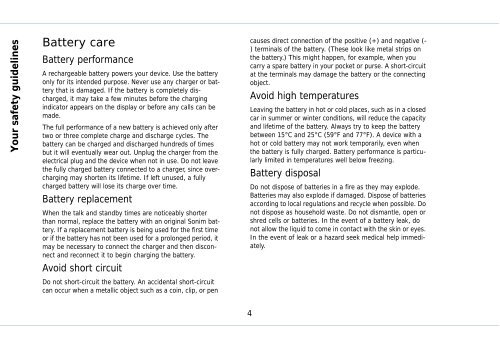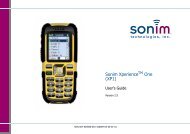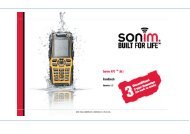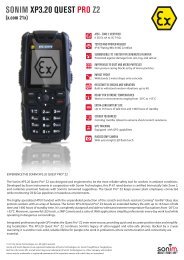Outgoing calls - Sonim Technologies
Outgoing calls - Sonim Technologies
Outgoing calls - Sonim Technologies
Create successful ePaper yourself
Turn your PDF publications into a flip-book with our unique Google optimized e-Paper software.
Your safety guidelines<br />
Battery care<br />
Battery performance<br />
A rechargeable battery powers your device. Use the battery<br />
only for its intended purpose. Never use any charger or battery<br />
that is damaged. If the battery is completely discharged,<br />
it may take a few minutes before the charging<br />
indicator appears on the display or before any <strong>calls</strong> can be<br />
made.<br />
The full performance of a new battery is achieved only after<br />
two or three complete charge and discharge cycles. The<br />
battery can be charged and discharged hundreds of times<br />
but it will eventually wear out. Unplug the charger from the<br />
electrical plug and the device when not in use. Do not leave<br />
the fully charged battery connected to a charger, since overcharging<br />
may shorten its lifetime. If left unused, a fully<br />
charged battery will lose its charge over time.<br />
Battery replacement<br />
When the talk and standby times are noticeably shorter<br />
than normal, replace the battery with an original <strong>Sonim</strong> battery.<br />
If a replacement battery is being used for the first time<br />
or if the battery has not been used for a prolonged period, it<br />
may be necessary to connect the charger and then disconnect<br />
and reconnect it to begin charging the battery.<br />
Avoid short circuit<br />
Do not short-circuit the battery. An accidental short-circuit<br />
can occur when a metallic object such as a coin, clip, or pen<br />
causes direct connection of the positive (+) and negative (-<br />
) terminals of the battery. (These look like metal strips on<br />
the battery.) This might happen, for example, when you<br />
carry a spare battery in your pocket or purse. A short-circuit<br />
at the terminals may damage the battery or the connecting<br />
object.<br />
4<br />
Avoid high temperatures<br />
Leaving the battery in hot or cold places, such as in a closed<br />
car in summer or winter conditions, will reduce the capacity<br />
and lifetime of the battery. Always try to keep the battery<br />
between 15°C and 25°C (59°F and 77°F). A device with a<br />
hot or cold battery may not work temporarily, even when<br />
the battery is fully charged. Battery performance is particularly<br />
limited in temperatures well below freezing.<br />
Battery disposal<br />
Do not dispose of batteries in a fire as they may explode.<br />
Batteries may also explode if damaged. Dispose of batteries<br />
according to local regulations and recycle when possible. Do<br />
not dispose as household waste. Do not dismantle, open or<br />
shred cells or batteries. In the event of a battery leak, do<br />
not allow the liquid to come in contact with the skin or eyes.<br />
In the event of leak or a hazard seek medical help immediately.

















